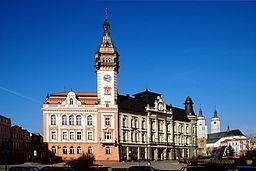- summer (DST) CEST (UTC+2) Area 44.29 km² Team TJ Sokol Krásné Loučky | Elevation 316 m Local time Saturday 11:26 AM | |
 | ||
Weather 7°C, Wind SW at 31 km/h, 75% Humidity Points of interest Cvilín, Krnov Synagogue, Městské muzeum Krnov, Švédská zeď, Zřícenina hradu Šelenburk | ||
Krnov ( [ˈkr̩nof]; Silesian: Karńůw, German: Jägerndorf, Polish: Karniów or Krnów, Latin: Carnovia) is an Upper Silesian town in the northeastern Czech Republic, in the Moravian-Silesian Region, the District of Bruntál.It lies on confluence of the rivers Opava and Opavice, near the Polish border. From 1938 to 1945 it was one of the municipalities in Sudetenland.Its history reaches up to 13th century when Krnov acquired city rights. The area is inhabited almost without any interruptions since the stone age.
Contents
Map of 794 01 Krnov, Czechia
An industrial center of the Upper-Silesian region, it manufactures textiles (especially woolens), beverages (including the most popular Czech soft drink Kofola) and musical instruments (notably organs and guitars). It is also a summer resort and a winter sport area with close access to the Jeseníky Mountains, the second-highest mountain range in the country. The city was founded in 1221 and served as the capital of an independent duchy from 1377 to 1523. Krnov has an 18th-century castle, several churches and abbeys as well as a lookout tower from 1903. The Krnov Synagogue is one of the few large synagogues to have survived the Nazi occupation of Europe. Krnov has two rail stations, central station and rail station called Cvilin. In Krnov is factory producing cola-based drink Kofola. One of the big local companies is a company rieger-kloss which makes organs (musical instrument).
Pre-War History
According to the Austrian census of 1910, the town had 16,681 inhabitants, 15,647 of whom had permanent residence there. The census had asked people for their native language; 15,390 (98.4%) were German-speaking and 247 (1.5%) were Czech-speaking. Jews were not allowed to declare Yiddish, thus most of them declared German as their native language. The most populous religious groups were Roman Catholics with 15,290 (91.7%), followed by Protestants with 885 (5.3%) and the Jews with 459 (2.8%). After World War2 the German population was expelled.
People
Twin towns — Sister cities
Krnov is twinned with:
